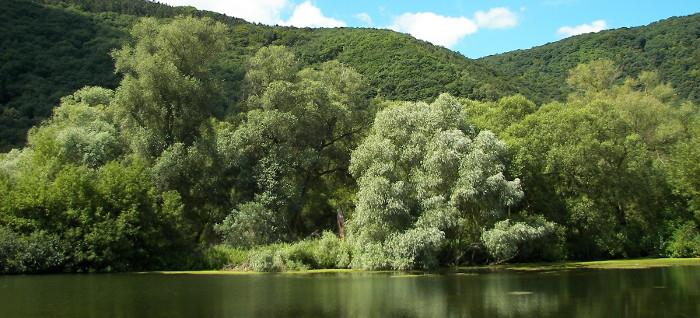
A GREEN ECOLOGICAL ROLE
This abundant and varied vegetation bordering the rivers is called riparian forest.
We can distinguish three floors:
- trees: ash, poplar, white willow, etc.
- shrubs: privet, dogwood, bushy willows, etc.
- herbaceous: nettle, "reeds" etc.
The distribution of species is:
- along the river, according to the climate and the soil;
- on both sides of the river depending on the proximity of the water.
Thus we find schematically the willows and alders near the water, the oaks at the top of the bank and between the two on the slope, ash trees, poplars ...
The role of riparian forest is essential for the river because it fulfills multiple functions.
The functions of riparian forest
Filter effect and purifier
• Filters the contributions of the watershed:
-promoting infiltration rather than runoff
- by eliminating nitrates. These are the salts of nitric acid, whose presence in water indicates a pollution of agricultural, urban or industrial origin
- by trapping phosphates. These salts of phosphoric acid, the excess of which leads to the modification and degradation of the aquatic environment, sometimes lead to the death of higher animal and plant organisms.
Fight against erosion of agricultural land by retaining particles.
Filter the exchanges between the river and its accompanying water table (alluvial water table *).
Hold back dead wood on the bank or floating during floods.
These phenomena contribute to the self-purification of the river.
Self-purification is the result of natural activities - physical, chemical and biological - allowing the river to assimilate, to reduce more or less certain pollution.
* The surface water, that which one sees in the river, is only part of the present water. The river is accompanied by an alluvial aquifer fed either by the infiltration of rainwater or by the river itself. The exchanges between the river and the aquifer - and the filtration that the root systems operate - are permanent in one or the other direction.
However, be careful, do not imagine the alluvial water as an underground lake. It is rather all the water contained in the spaces between the sediments (sand, pebbles ...) deposited by the river over millennia. The exchange zone contains a suitable fauna, microorganism, invertebrates, which participate in the self-purification of water.
Maintaining the banks
This maintenance is done:
by the root system of a vegetation particularly adapted to the embankment and the proximity of the water. Precisely, they are the willows, the ash trees, the alders and even the white poplars, or most shrubs and herbaceous plants. which, thanks to their roots, stabilize the banks.
by the presence of grasses and shrubs whose stems and leaves, clad by the current, protect the soil from erosion.
Flood prevention
During floods, plants are opposed to the current. They dissipate their energy, thus reducing their speed by limiting erosion and the spread of floods. The jams are trees and various objects obstructing the riverbed. In some cases, they also help slow down the flow and prevent serious flooding. Indeed, jams facilitate the operation of expansion areas that are natural areas, sometimes vineyards and wasteland flooded during floods. They allow spreading of floodwaters and thus preserve dwellings and infrastructures.
Ecological functions
The ripisylve diversifies the environment. She plays with the sun to give shade or light. Ice jams cause the current to slow down, but also create small falls and eddies. The riverine offers all the wildlife caches and shelters: hollow trees, sub-cellars, jams ... It represents a source of food - berries, plant debris, insects falling trees, etc.- and provides breeding grounds in its meadows and roots ...
The riverine is a space of exchanges, called ecotone, between the terrestrial environments and the aquatic environment. By its continuous presence along the river, it guides and allows the circulation of wildlife in relative safety by providing a corridor effect.
Other roles
Shading: tall trees provide shade that limits the warming of the water.
The landscape: the wooded strip bordering streams is a structuring element of the landscape. It gives it its picturesque and characteristic appearance.
Society: Formerly, the additional income (heating, fodder, tool sleeves, rot-proof water pipes, etc.) that could provide the alluvial forest was not negligible. Today, the river is primarily a place of leisure, to practice in the greatest respect of the environment.
Caution
Without management, the riparian forest does not present only advantages. It can contribute to the standardization of aquatic environments and the degradation of water quality. The stagnation and warming of the water is then observed because of ice jams and excessive inputs of plant debris, which, when degrading, consume oxygen.
The riparian forest without management can also be a hazard during heavy floods, particularly in the immediate vicinity of bridges, causing a plug effect.

